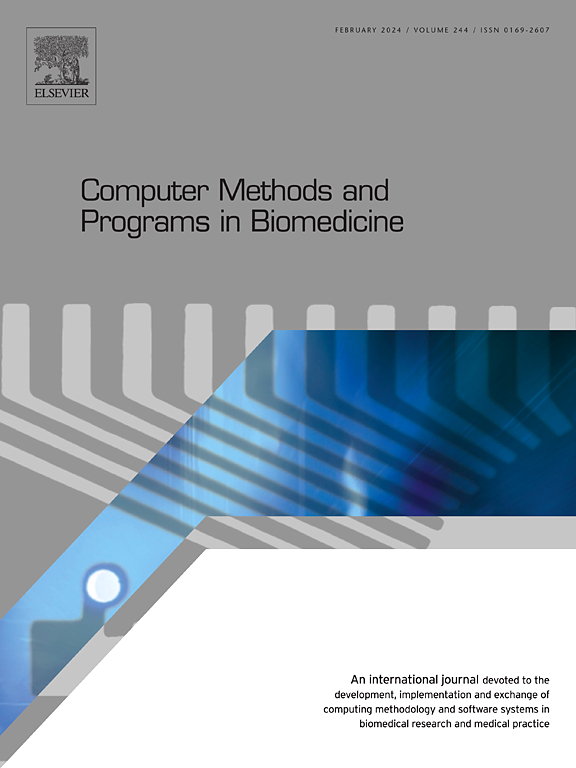Advancing chest X-ray diagnostics: A novel CycleGAN-based preprocessing approach for enhanced lung disease classification in ChestX-Ray14
IF 4.9
2区 医学
Q1 COMPUTER SCIENCE, INTERDISCIPLINARY APPLICATIONS
引用次数: 0
Abstract
Background and objective:
Chest radiography is a medical imaging technique widely used to diagnose thoracic diseases. However, X-ray images may contain artifacts such as irrelevant objects, medical devices, wires and electrodes that can introduce unnecessary noise, making difficult the distinction of relevant anatomical structures, and hindering accurate diagnoses. We aim in this study to address the issue of these artifacts in order to improve lung diseases classification results.
Methods:
In this paper we present a novel preprocessing approach which begins by detecting images that contain artifacts and then we reduce the artifacts’ noise effect by generating sharper images using a CycleGAN model. The DenseNet-121 model, used for the classification, incorporates channel and spatial attention mechanisms to specifically focus on relevant parts of the image. Additional information contained in the dataset, namely clinical characteristics, were also integrated into the model.
Results:
We evaluated the performance of the classification model before and after applying our proposed artifact preprocessing approach. These results clearly demonstrate that our preprocessing approach significantly improves the model’s AUC by 5.91% for pneumonia and 6.44% for consolidation classification, outperforming previous studies for the 14 diseases in the ChestX-Ray14 dataset.
Conclusion:
This research highlights the importance of considering the presence of artifacts when diagnosing lung diseases from radiographic images. By eliminating unwanted noise, our approach enables models to focus on relevant diagnostic features, thereby improving their performance. The results demonstrated that our approach is promising, highlighting its potential for broader applications in lung disease classification.
推进胸部x线诊断:一种新的基于cyclegan的预处理方法,用于增强胸腔x - ray14中肺部疾病的分类
背景与目的:胸部x线摄影是一种广泛应用于胸部疾病诊断的医学影像学技术。然而,x射线图像可能包含诸如不相关的物体、医疗设备、电线和电极等伪影,这些伪影会引入不必要的噪声,使相关解剖结构的区分变得困难,并妨碍准确诊断。我们在这项研究的目的是解决这些伪影的问题,以提高肺部疾病的分类结果。方法:在本文中,我们提出了一种新的预处理方法,该方法首先检测包含伪影的图像,然后我们通过使用CycleGAN模型生成更清晰的图像来降低伪影的噪声影响。用于分类的DenseNet-121模型结合了通道和空间注意机制,专门关注图像的相关部分。数据集中包含的附加信息,即临床特征,也被整合到模型中。结果:我们在应用我们提出的伪影预处理方法之前和之后评估了分类模型的性能。这些结果清楚地表明,我们的预处理方法显著提高了模型的AUC,肺炎的AUC提高了5.91%,实变分类的AUC提高了6.44%,优于之前对chex - ray14数据集中的14种疾病的研究。结论:本研究强调了从放射影像诊断肺部疾病时考虑伪影存在的重要性。通过消除不必要的噪声,我们的方法使模型能够专注于相关的诊断特征,从而提高其性能。结果表明,我们的方法是有希望的,突出了其在肺部疾病分类中更广泛应用的潜力。
本文章由计算机程序翻译,如有差异,请以英文原文为准。
求助全文
约1分钟内获得全文
求助全文
来源期刊

Computer methods and programs in biomedicine
工程技术-工程:生物医学
CiteScore
12.30
自引率
6.60%
发文量
601
审稿时长
135 days
期刊介绍:
To encourage the development of formal computing methods, and their application in biomedical research and medical practice, by illustration of fundamental principles in biomedical informatics research; to stimulate basic research into application software design; to report the state of research of biomedical information processing projects; to report new computer methodologies applied in biomedical areas; the eventual distribution of demonstrable software to avoid duplication of effort; to provide a forum for discussion and improvement of existing software; to optimize contact between national organizations and regional user groups by promoting an international exchange of information on formal methods, standards and software in biomedicine.
Computer Methods and Programs in Biomedicine covers computing methodology and software systems derived from computing science for implementation in all aspects of biomedical research and medical practice. It is designed to serve: biochemists; biologists; geneticists; immunologists; neuroscientists; pharmacologists; toxicologists; clinicians; epidemiologists; psychiatrists; psychologists; cardiologists; chemists; (radio)physicists; computer scientists; programmers and systems analysts; biomedical, clinical, electrical and other engineers; teachers of medical informatics and users of educational software.
 求助内容:
求助内容: 应助结果提醒方式:
应助结果提醒方式:


